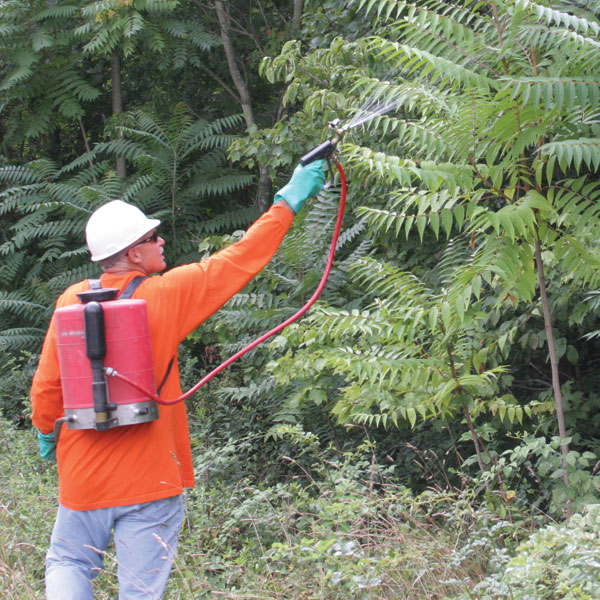Management Practices Within Right-of-Way Study Areas
Treatment units within the SGL33 right-of-way project area historically included hand-cutting, herbicides, and mowing alone or in combination with herbicides applied across the entire width of the right-of-way. Although herbicides and application methods varied over the years as new products and techniques became available, specific treatment units (whether mowing, hand-cutting, or herbicides) have remained consistent since 1953.
Integrated Vegetation Management on Transmission Rights of Way Involves Two Phases:
- Using herbicides and/or mechanical treatments to initially control undesirable trees incompatible with management objectives for right-of-way function.
- Developing a tree-resistant plant cover type to reduce reinvasion of tall-statured trees such as white oak (Quercus alba) or red maple (Acer rubrum).
A brief description of integrated vegetation management treatments are shown in Table 1. Click here to read a more detailed treatment history.
Table 1
Integrated vegetation management practices applied on State Game Lands 33 (SGL33) and Green Lane Research and Demonstration Area (GLR&D). Photos by Kristin Wild
High Volume Foliar
Wire Zone

A diluted herbicide solution is applied to the foliage of target vegetation using hydraulic equipment. This treatment uses a large volume of water per acre (usually 100 + gallons) and is applied on sites where incompatible vegetation is very dense and tall. Selective herbicides are used which maintain the grasses while incompatible trees and shrubs are treated. Herbicide application may be broadcast on larger areas or applied as a spot treatment on smaller areas.
Ultra Low Volume Foliar
Wire Zone

This application method allows for selective treatment of target vegetation without impacting surrounding desirable plant species. This treatment uses the Thinvert application system whereby selected herbicides are mixed with an oil based material and applied using a unique nozzle design. This method of application results in less total volume of solution applied per acre (typically 5 gallons per acre or less). Best suited for vegetation under eight feet tall.
Mow
Wire*/Border Zone

Mechanical equipment is used to cut and mulch vegetation from the site. This method is non-selective and is typically used to reclaim an area from tall, dense brush. The root system of mowed vegetation is not affected which frequently results in dense thickets of re-sprouted brush in areas where brush existed prior to mowing.
*Mowing Only
Mow + Cut Stubble
Wire Zone

Mechanical equipment is used to cut and mulch vegetation leaving only cut stubble behind. Following mechanical cutting and typically before woody vegetation re-sprouts, a diluted herbicide mixture of selective broadleaf residual herbicides is applied to cut stems and soil of the treatment area. This treatment relies on the stems and roots of incompatible woody plants absorbing herbicides and providing long-term woody plant control. Herbaceous plants and grasses colonize the treatment area within months of application.
Low Volume Basal
Wire & Border Zone

Herbicides are applied to individual target plants to selectively control trees and shrubs up to 6 inches in diameter without harming surrounding vegetation. This treatment uses an oil based herbicide and carrier. The mixture is applied to the entire circumference of the stem from the ground to a height of about 12 to 15 inches.
Hand Cutting

This technique involves individually cutting target vegetation usually with a chainsaw. All or part of the above-ground portion of the incompatible vegetation is cut. The root system of the incompatible vegetation is not affected which frequently results in dense thickets of re-sprouted brush.